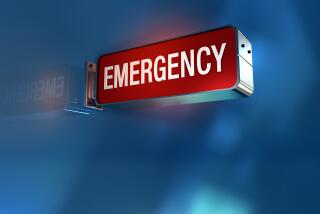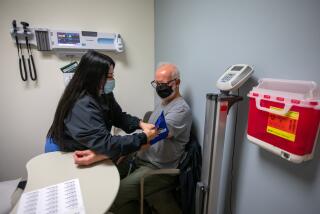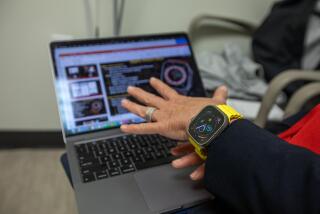Read up now, get better care later
A doctor visit or hospital stay is not something most people look forward to. But the experience needn’t be unpleasant -- or hazardous to your health. That’s the general theme of three recent books that aim to help consumers get the best medical care possible at a time when healthcare costs are soaring.
How to Survive Your Hospital Stay
The Complete Guide to Getting the Care You
Need -- and Avoiding Problems You Don’t
Gail Van Kanegan and Michael Boyette
Simon & Schuster: 248 pages, $14
Van Kanegan, a nurse practitioner, and Boyette, a veteran medical journalist and expert in hospital safety, have joined forces to offer sound advice. The gist of their counsel is get well -- and get out of the hospital as quickly as possible.
The risks posed by hospital stays range from medical errors, such as giving the wrong drug or improper dosage to patients, to hospital infections, which the authors note “rank as the fourth most common cause of death in America, killing more people than auto accidents and homicides combined.”
The authors begin by helping readers determine whether a hospital stay is necessary. They then probe the top 10 hospital risks, including medication errors, infections, surgical complications, misdiagnoses and malnutrition. The authors stress asking doctors and nurses questions, from “Would you mind washing your hands?” to “What side effects of this drug should I be aware of?”
Kanegan and Boyette conclude by offering tips on how to receive good follow-up care. At the back of the book is a thorough resource guide, including recommended books, websites and addresses and phone numbers for government agencies and support groups.
*
Special Treatment
How to Get the Same High-Quality Health Care Your Doctor Gets
Dr. Kevin J. Soden, Dr. Christine Dumas
Berkley Books: 310 pages, $23.95
Getting first-rate medical care is not necessarily about money, one’s insurance plan or connections, write the authors. It’s about knowledge. In their book, the medical correspondents for NBC’s “Today” show share what doctors know about which medical tests to demand, how to choose a doctor and hospital, how to get the best treatment in the ER, and how to avoid hospital infections.
Soden (an ER physician for 23 years) and Dumas (a practicing dentist and professor at USC’s School of Dentistry) also broach broader topics, such as how to prevent and treat the top three killers of adults and how to reduce the risk of the most preventable cancers.
For example, the authors say that many people are at high risk for heart attack and stroke even though their cholesterol and blood pressure are normal. They recommend a test that they say is a better indicator of heart disease: an inexpensive C-reactive protein test, which measures inflammation.
*
Understanding Healthcare
Richard Saul Wurman
Top Publishing Group: 333 pages, $25
Jam-packed with information, statistics and advice, Wurman’s book (which received major funding from Johnson & Johnson) is almost overwhelming. Rather than a narrative, it’s a series of graphics, charts and illustrations on everything from car accidents to eating disorders to what a hospital intensive care unit looks like. (Wurman is perhaps best known for his “Access” travel guides.)
The book is divided into three sections: “Understanding Yourself,” about the human body; “Understanding Them,” about medical professionals; and “Making It Happen,” about medical access, costs and coverage. Because of the book’s extensive scope, most topics receive only a two-page spread, which means they aren’t covered with much depth.
“Understanding Healthcare” is valuable as a broad overview, providing interesting facts about myriad topics, but it is not for readers looking for in-depth coverage of specific healthcare issues.






